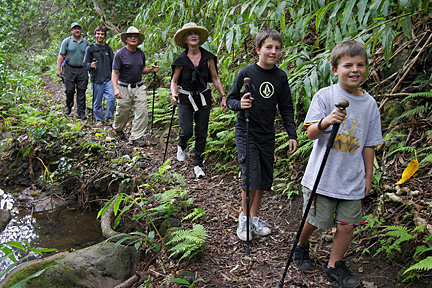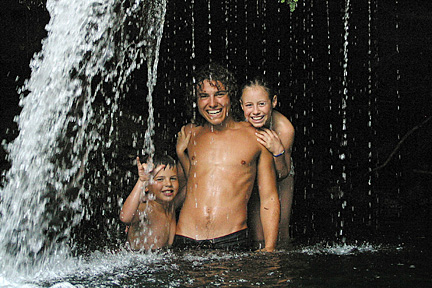
|
Hawaii’s
Back Yard |
Admire the beauty of
life-giving water
A 1.5-mile tour takes visitors
through lush areas of North Kohala
on the Big Island
A Hawaiian chant observes: "Uwe ka lani ola ka honua" -- the heavens cry, the earth lives.Centuries ago, streams fed by rain were diverted via bamboo pipes or auwai (ditches) to irrigate fields of taro, sweet potatoes and other crops. Water bubbling from springs and dripping from the ceilings of caves was collected into gourds for drinking. Villagers bathed, washed, prepared food and performed purification rituals with water. In short, the ancients regarded water as the source of ola (life), a precious gift from the gods.
Nowhere is this more evident than North Kohala on the Big Island, the lush setting for Hawaii Forest & Trail's half-day Kohala Country Waterfalls Adventure.
Here, rainfall feeds abundant plant life and hundreds of waterfalls ranging from 6 to hundreds of feet high.
During the excursion, you'll learn how water shaped a magnificent montage of valleys, cliffs and streams, as well as the Hawaiians' lives.
Ideal for families, even those with young children, the trip begins with a drive along the sunny Kona-Kohala coast, between expansive fields of a'a (coarse) and pahoehoe (smooth) lava. Heading north, the temperature cools, and the landscape turns from desolate black to vivid green.
You'll cruise through the quaint towns of Hawi and Kapaau, which were abuzz with activity when several sugar plantations were operating in North Kohala a century ago. At the end of the road, you can stretch your legs and admire a magnificent view of Pololu Valley and its quarter-mile-long black-sand beach.
Long ago, Pololu was a bountiful source of water-worn stones the Hawaiians used to build homes, shrines and other structures. Massive Puukohola Heiau (pre-Christian place of worship), 25 miles away in Kawaihae, was supposedly constructed from stones from Pololu that were passed hand to hand by a line of people that stretched, unbroken, between the sites.
Back in the van, be sure to buckle your seat belt. A bumpy 15-minute ride through verdant pastureland takes you to the start of an easy 1.5-mile walk that showcases nature all along the way.
"The trail goes through a rain forest that's on private land, so going on this tour is the only way you're able to see this beautiful area," says guide Taro Watanabe. "We keep a relaxed pace so participants have plenty of time to stop and smell the roses, so to speak."

Water shaped the terrain in North Kohala where visitors explore the source of ola, life, on foot.
Watanabe usually will break open a nut from the kukui, Hawaii's state tree, revealing its oily flesh. "The nuts were strung together by the Hawaiians and lit as candles," he explains. "They also were roasted and mashed to make a salve for sores. Eat just three of them and you'll find they're a potent laxative. Kukui oil also is widely used now as a massage oil."
The trail crosses the Opaepilau and Waikama streams and four bridges along the famous Kohala Ditch, a 22.5-mile irrigation system that was built a century ago to carry water from the rain-soaked mountains, which receive more than 200 inches of annual rainfall, to the sugar cane fields near the drier coast. At its peak the ditch diverted about 30 million gallons of water in a 24-hour period.
Remnants of an ancient taro patch, or lo'i, marked by a deteriorating stone wall, lie hidden in dense foliage beside a stream. Taro was a staple in old Hawaii, and farmers once tended hundreds of lo'i in this area.
"A small gate, which is no longer here, was used to control the flow of water from the stream," Watanabe said. "The gate was opened and the area was flooded for a few days before the taro was planted. There are about 200 species of taro; the wetland varieties need a constant source of flowing water like a stream."

A highlight of the Kohala Country Waterfalls Adventure is the opportunity to take a dip under a cascade of water.
In addition to taro, the Hawaiians cultivated bananas, breadfruit, sweet potatoes, sugar cane and yams in the kula sector around the 1,000-foot elevation, where the trail traverses. Wood was gathered in the wao kanaka and wao nahele areas.
Wao maukele, the wet upland region, was maintained as a conservation district.
"The Hawaiians knew they couldn't cut down all the trees and use all the resources," Watanabe says. "They had to be self-sufficient -- remember, they couldn't import anything back then. In order for them to survive and for the generations after them to survive, they had to preserve some areas of the forest."
Higher still was wao akua, where an ethereal mist often lingers.
"People rarely went there," Watanabe says. "It was believed to be a place inhabited only by spirits."
Seven lovely waterfalls grace the trail, and the highlight for many participants is taking a dip beside the last one.
"Everyone who swims in that pool is so happy," Watanabe said. "Even the older folks are laughing and splashing about just like kids. A lot of our guests come from mainland cities that aren't near forests. To be able to swim in a natural mountain pool with a waterfall flowing into it is a once-in-a-lifetime experience for them."
He recalled a family from the Midwest who recently took the tour. "The weather hadn't been good, and the water was chilly and a little brown from runoff. I told them, 'This isn't the best day for swimming.'
"The two teenage boys took off their shirts and said, 'We don't care! We came all the way here, and we're going to go in, no matter what!' And they did -- they jumped right in and had a grand time!"
Smiling at the memory, Watanabe said, 'That's the great thing about the Kohala Country Waterfalls Adventure. In the 90 minutes it takes to walk the trail, you develop a real appreciation for the beauty, grandeur and diversity of nature. An hour's drive from the Big Island's big resorts, you can be in an entirely different world."
If you go ...
What: Kohala Country Waterfalls AdventureMeet: At Hawaii Forest & Trail's headquarters, 74-5035-B Queen Kaahumanu Highway, about five miles south of Kona International Airport. A pickup also is made at Kings' Shops at Waikoloa Beach Resort on the Kohala Coast.
When: 7 a.m. or noon, depending on the day. Tours limited to 10 guests.
Cost: $99 for adults, $79 for infants through 12 (babies and toddlers are required to ride in a car seat, which takes up a van seat). Price includes fruit, breads, soft drinks, bottled water and use of walking sticks and rain gear. Kamaaina receive a 15 percent discount.
Call: 808-331-8505 on the Big Island; 800-464-1993 from the other islands or the mainland
E-mail: info@hawaii-forest.com
Web site: www.hawaii-forest.com
Notes: Wear comfortable clothing (shorts, closed-toe shoes, a T-shirt or casual top) and bring a swimsuit, jacket, towel and hat, cap or visor. Guests should be able to hike on uneven or rocky terrain in cool, wet or muddy conditions. Hawaii Forest & Trail offers six other nature tours, including birding excursions and expeditions to Hawaii Volcanoes National Park and Mauna Kea's summit. Call or check the Web site for details. The company plans to introduce one or two more tours late this year or early next.
E-mail to Travel Desk
[News] [Business] [Features] [Sports] [Editorial] [Do It Electric!]
[Classified Ads] [Search] [Subscribe] [Info] [Letter to Editor]
[Feedback]
